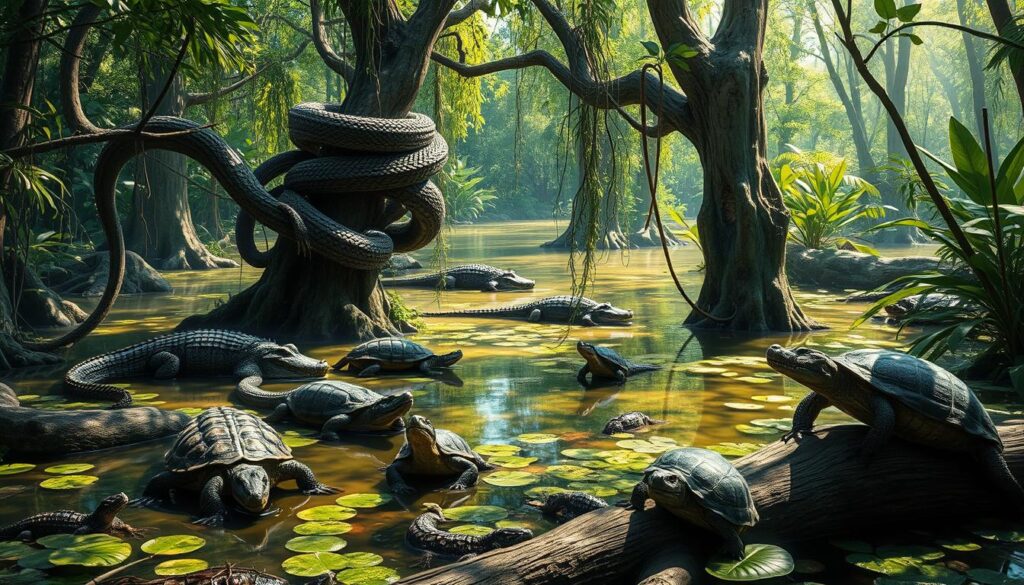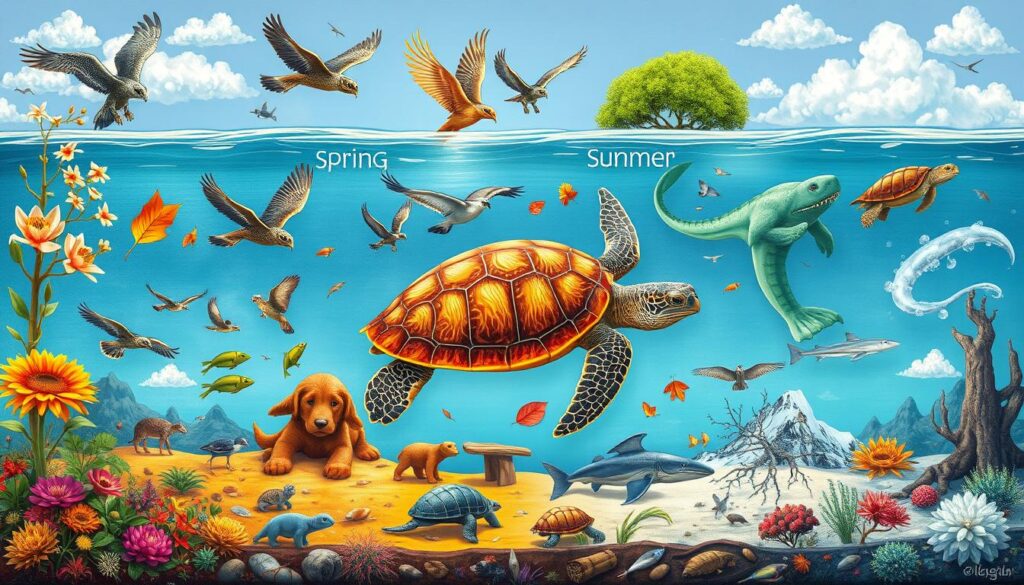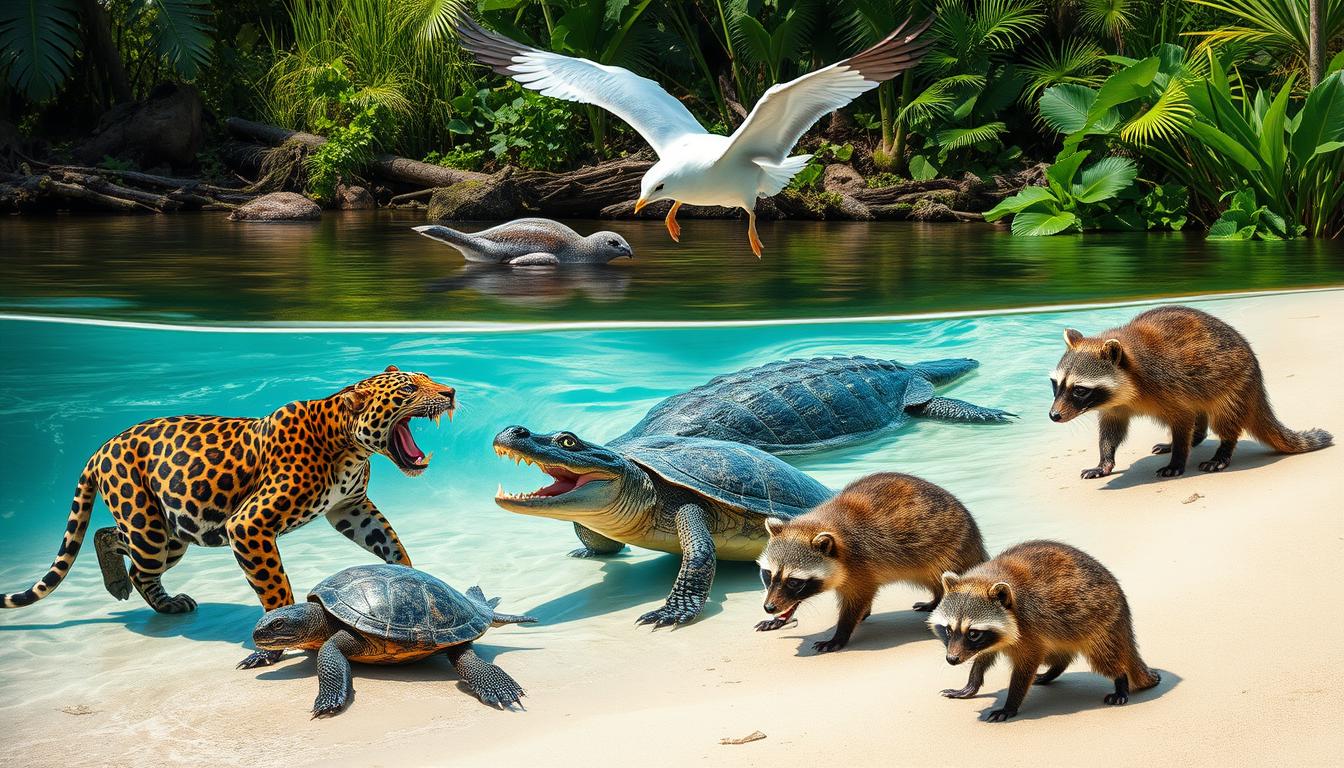Turtles have many threats in nature, from birds to fish. But what really eats them? Knowing who eats turtles helps us understand their survival and the balance of nature.
Turtles, despite their tough shells, face many predators. Birds and mammals are among them. This guide will show you who hunts turtles and how they affect turtle numbers.
Table of Contents
Understanding Turtle Vulnerability in Their Ecosystem
Turtles have been on Earth for millions of years. Yet, their survival is often at risk due to challenges in their ecosystems. It’s key to grasp the factors that make them vulnerable and how they fight these battles.
Natural Defense Mechanisms
Turtles rely on their shells as a main defense. These shells protect them from predators and dangers. Some turtles, like the snapping turtle, can be very aggressive when threatened.
However, turtles are slow and have exposed limbs. This makes them easy prey, especially when they’re laying eggs or are young.
Survival Challenges
Turtles face many survival challenges in their homes. Their slow pace makes them easy targets for predators. Nesting also puts their eggs and young at risk.
Habitat loss and fragmentation make things worse. Turtles have a hard time finding places to live, eat, and reproduce.
Habitat Impact on Predation
The quality of a turtle’s habitat affects how much they’re hunted. Good habitats with plenty of food and shelter help turtles avoid predators. But, habitat degradation and human changes can make things worse.
It’s vital to understand how turtles, their ecosystems, and threats interact. This knowledge is essential for creating strong conservation strategies to protect these amazing animals for the future.
What Eats Turtles: Complete Predator Overview
Turtles have shells and move slowly, making them prey for many. Creatures from the sky to the deep sea see turtles as food. The turtle food chain shows many predators that hunt these reptiles.
Herons, eagles, and crows hunt turtles from the air. They stalk in water or grab hatchlings from nests. Raccoons, foxes, and mink target turtle eggs and young. Fish like catfish and carp eat young turtles. Snapping turtles, water snakes, and alligators threaten turtles of all ages.
Predation affects turtles differently, based on their species and habitat. Some turtles hide or retreat into their shells to avoid predators. But, these defenses may not always save them, especially with habitat loss.
| Predator | Typical Size | Prey Preference |
|---|---|---|
| Saltwater Crocodile | 5.1 meters, 450 kg | Targets all life stages of turtles |
| Polar Bear | 2.5 meters, 600 kg | Primarily targets turtle eggs and hatchlings |
| Brown Bear | 2.8 meters, 390 kg | Opportunistic predator of turtles of all sizes |
| Komodo Dragon | 3 meters, 150 kg | Specializes in hunting adult turtles |
| Siberian Tiger | 4 meters, 360 kg | Rarely targets turtles, but may opportunistically hunt them |
Knowing who eats turtles helps us protect them. By understanding their challenges, we can save these amazing reptiles.
Avian Predators: Birds That Hunt Turtles
The natural world is full of predators that threaten turtles. Birds are a big part of this threat. They use different ways to catch turtles for food.
Herons and Their Hunting Techniques
Herons, like the great blue heron, are great at catching turtles. They have long, sharp beaks. They wait in the shallows for the perfect time to strike.
They use their beaks to catch small turtles. Then, they eat them right away or take them back to feed their young.
Eagles as Apex Predators
Eagles are at the top of the bird food chain. Bald eagles and golden eagles can lift turtles out of the water. They target turtles with shells up to 25 centimeters long.
They grab turtles with their strong talons. Sometimes, they eat them right away. Other times, they fly to a safe spot to enjoy their meal.
Crow Predation Patterns
Crows are smart and adaptable, making them a threat to turtles. They raid turtle nests, eating eggs and hatchlings. They also flip over small turtles to eat them.
Crows can stress adult turtles too. This stress can lead to their death. Understanding crows’ behavior helps protect turtles.
Avian predators are key in shaping turtle populations. They are especially dangerous during nesting and hatching seasons. Knowing how these birds hunt helps us protect turtles.
Mammalian Threats to Turtle Populations
Several mammalian predators threaten turtle survival. Raccoons, in particular, are a big problem. They are opportunistic omnivores that can harm turtle populations a lot.
Raccoons prey on turtle eggs and smaller turtles. Their diet can be up to 75% turtles in spring and summer. They can climb and reach turtle nests, making it hard for turtles to survive.
Foxes also target turtles. They hunt basking turtles and can be found in up to 20% of fox scat samples. Their sneaky hunting and sharp senses make them a big threat.
Mink are another danger to turtles. They are good swimmers and can chase turtles underwater. They eat up to 15% of their diet from reptiles, including turtles.
| Mammalian Predator | Hunting Tactics | Percentage of Turtle Prey |
|---|---|---|
| Raccoons | Opportunistic, climb to access nests | Up to 75% of diet in spring and summer |
| Foxes | Stealthy, target basking turtles | Up to 20% of scat samples |
| Mink | Skilled swimmers, chase turtles underwater | Up to 15% of diet |
These mammalian predators are a big threat to turtles. They can harm turtle populations, especially where their habitats meet. Knowing about these predators and how they hunt is key to saving turtles.
Aquatic Predators in Turtle Habitats
In the turtle ecosystem, predators in the water are key. They affect turtle numbers, especially young ones. Fish and other predators threaten turtles in their turtle habitat.
Fish Species That Target Turtles
Many fish eat turtles, especially their eggs and young. Catfish use their barbels to find turtle hatchlings and eggs. Carp also eat turtle eggs and nibble on young turtles.
Bass are the biggest threats to turtle hatchlings. They can eat up to 90% of them in some places. Bass are good at hunting in open water, where young turtles are most vulnerable.
Water-Based Hunting Strategies
Predators in the water hunt in different ways. Fish are stealthy and quick, making it hard for turtles to defend themselves. Catfish use their senses to find turtles. Bass are fast and agile, catching turtles off guard.
Impact on Juvenile Turtles
Young turtles face big dangers from predators. They are small and can’t defend themselves well. This leads to high death rates in some turtle habitats.
Turtles always face the fight to survive. Knowing about the dangers from water predators helps us protect them. We need to save these amazing creatures and their turtle ecosystem.
Reptilian Predators of Turtles
The world of turtles is filled with many predators. Among the most dangerous are reptiles that live in the same places as turtles. From snapping turtles to water snakes, these hunters are a big threat to turtles of all kinds.
Snapping turtles can exert over 600 pounds per square inch of jaw pressure. They prey on smaller turtles. Their strong, hooked beaks can break through even the toughest turtle shells.
Water snakes have sharp, backward-curving teeth. They are great at catching and eating young turtles. These quick snakes can strike fast, making them a danger to the most vulnerable turtles.
Alligators and crocodiles are the most frightening predators. They can crush the biggest turtle shells with their strength. As top predators, they threaten turtles of all sizes.
The variety of reptilian hunters shows the constant battle turtles face to survive. Knowing about these threats helps us protect turtles. It’s key to saving them for future generations.

Threats to Turtle Eggs and Hatchlings
Efforts to save turtles often focus on protecting eggs and hatchlings. These young turtles face many dangers early in their lives. It’s important to understand these challenges to help them survive.
Nest Predation
Turtle eggs are easy prey for raccoons, skunks, foxes, and crows. These smart predators can find and destroy turtle nests. Anthropogenic coastal developments have made this problem worse, attracting more predators like coyotes, dogs, and wild boars.
Hatchling Vulnerability
After hatching, young turtles face new dangers. Fish, birds, and mammals are threats as they try to reach the ocean. Sadly, only about 10% of sea turtle hatchlings make it to adulthood.
Survival Rates
| Turtle Species | Hatchling Survival Rate |
|---|---|
| Leatherback | 1 in 1,000 |
| Loggerhead | 1 in 4,000 |
| Green | 1 in 1,000 |
| Hawksbill | 1 in 5,000 |
The chances of turtle hatchlings surviving are very low. Some species have less than a 0.1% chance of making it to adulthood. Conservation efforts aim to improve these odds by protecting nests and increasing hatchling survival rates.
Seasonal Variations in Predation Patterns
It’s key to understand how the turtle ecosystem and turtle food chain change with the seasons. Turtles face more danger during nesting and hatching times. In spring and summer, when turtles are most active, they are at higher risk of being hunted.
Winter might seem like a safer time for turtles, but they’re not completely out of danger. Some predators can find turtles even when they’re hiding. Knowing these changes helps us protect turtles better.
| Season | Predation Patterns | Turtle Vulnerability |
|---|---|---|
| Spring/Summer | Increased predation rates due to higher turtle activity and predator abundance | Heightened risk during nesting and hatching periods |
| Fall/Winter | Temporary respite from predation, but specialized predators can still access turtles | Reduced activity and dormancy offer some protection, but turtles remain vulnerable |
By understanding these patterns, we can make better plans to protect turtles. This helps in managing habitats, controlling predators, and raising awareness. It’s all about keeping turtles safe in their turtle ecosystem and turtle food chain.

Human Impact on Turtle Predation
Human actions have made sea turtles more at risk from predators. Things like habitat loss, pollution, and climate change have hurt them. Also, invasive species like the red-eared slider turtle compete with native turtles for space.
Habitat Destruction Effects
Coastal development and human activities threaten sea turtle homes. This makes it harder for them to find safe places to nest and feed. As a result, predators can more easily find and harm turtles, especially young ones.
Conservation Challenges
Protecting sea turtle habitats and controlling invasive species are key to saving them. We also need to reduce plastic pollution and prevent fishing injuries. Turtle conservation is a big challenge, but it’s vital for our oceans’ health.

